Compression Characteristics of Highly Compacted and Tamped Loess Soil Fills
Abstract
1. Introduction
2. Materials and Methods
2.1. Proposal for Comprehensive Compaction Technology
2.2. Trial Application
2.3. Soil Mechanics of Filling Soil
2.4. Monitoring of Post-Construction Settlement
3. Results and Discussion
3.1. Working Mechanism of Heavy Tamping
3.2. Degree of Compaction of the Embankment Soil
3.3. Compression Modulus of the Embankment Body
3.4. Post-Construction Settlement
3.5. Post-Construction Settlement Prediction
3.6. Discussion on the Application of Analogous Engineering
4. Conclusions
- (1)
- When a filling soil with layered rolling experienced heavy tamping, its degree of compaction and compression modulus were greatly improved and appeared in a periodic sawtooth curve shape according to the filling depth. The analysis results for the degree of compaction, compression modulus, and post-construction settlement of the filling body show that for the loess layers after compaction by rollers, the working mechanism of further heavy tamping was a re-compacting effect.
- (2)
- Compared to the compression modulus of the filling soil with layered rolling using rollers only, the compression modulus was improved by 50–100% with comprehensive compaction. Further analysis of the compression modulus showed that compared to the settlement with layered rolling only, the settlement of the filling body with comprehensive compaction can be reduced by almost 40%.
- (3)
- The settlement monitoring results showed that the settlement rate of the filling body with comprehensive compaction tended to be large at first and subsequently smaller over time. The post-construction settlement of the filling body that finally tended to be stable was smaller than 0.1% of the embankment height, which was significantly reduced compared to similar embankment projects using layered rolling only. The compression deformation of the filling body itself in this project was the major constituent of the total settlement.
- (4)
- The post-construction settlement of the filling body increases with time following a logarithmic relationship.
- (5)
- The comprehensive compaction technology can be used to enhance the embankment compaction effects, effectively reducing post-construction settlement for the loess-filled high embankment.
- (6)
- Construction parameters for the comprehensive compaction technology should be appropriately optimized based on different soil properties before implementation.
Author Contributions
Funding
Data Availability Statement
Conflicts of Interest
References
- Goktepe, F.; Keskin, I. A Comparison Study between Traditional and Finite Element Methods for Slope Stability Evaluations. J. Geol. Soc. India 2018, 91, 373–379. [Google Scholar] [CrossRef]
- Yang, C.W.; Zhang, J.J.; Wang, Z.Z.; Hou, J.Q.; Si, C.L. Model Test of Failure Modes of High Embankment and Aseismic Measures for Buried Strike-Slip Fault Movement. Environ. Earth Sci. 2018, 77, 233. [Google Scholar] [CrossRef]
- Nazir, N.; Moayedi, H.; Subramaniam, P.; Gue, S.S. Application and Design of Transition Piled Embankment with Surcharged Prefabricated Vertical Drain Intersection over Soft Ground. Arab. J. Sci. Eng. 2018, 43, 1573–1582. [Google Scholar]
- Jie, Y.X.; Wei, Y.J.; Wang, D.L.; Wei, Y.F. Numerical Study on Settlement of High-Fill Airports in Collapsible Loess Geomaterials: A Case Study of Lüliang Airport in Shanxi Province, China. J. Cent. South Univ. 2021, 3, 939–953. [Google Scholar] [CrossRef]
- Tang, D.; Yang, Y.H. Calculation and Analysis of Relationship Between Embankment Height and Settlements Deformation. Technol. Highw. Transp. 2007, 9, 1–3. [Google Scholar]
- Meng, X.Q.; Wei, X.Y.; Liang, L. Probe into Boundary Pressure and Boundary Water Content for the Deformation of Collapsible Loess. Sci. Tech. Inf. Dev. Econ. 2000, 10, 44–45. [Google Scholar]
- Li, J.; Bai, X.H.; Ma, F.L. Energy Transfer and Influencing Factors in Soil during Compaction. PLoS ONE 2020, 20, e0242622. [Google Scholar] [CrossRef]
- Buathong, P.; Chompoorat, T.; Jongpradist, P.; Chen, X.; Jamsawang, P. Effect of Palm Fiber Reinforcement on the Unconfined Compressive Performance of Cement-Treated Sand. Sustainability 2023, 15, 8607. [Google Scholar] [CrossRef]
- Chompoorat, T.; Thepumong, T.; Taesinlapachai, S.; Likitlersuang, S. Repurposing of stabilised dredged lakebed sediment in road base construction. J. Soils Sediments 2021, 21, 2719–2730. [Google Scholar] [CrossRef]
- Wang, J.L.; Liu, Y.L.; Shen, X.F.; Peng, S.P. Experimental Investigation on Treatment of Loess Subgrade with Impaction and Grind Method (IGM). Rock Soil Mech. 2005, 26, 755–758. [Google Scholar]
- Lou, G.C. Application of Impact Compaction Technology in Highway Embankment of Collapsiable Loess Soils. Chin. J. Rock Mech. Eng. 2005, 24, 1207–1210. [Google Scholar]
- Jing, H.J.; Zhang, B. Experiments of Highway Subgrade Impact Compaction in Loess Region. J. Chang’an Univ. (Nat. Sci. Ed.) 2004, 24, 25–29. [Google Scholar]
- Feng, J.; Liu, Y.J.; Lu, X.M.; Chen, Z.K.; Wu, J.; He, J.Z.; Zhao, Z.Y. Engineering Characteristics of Unsaturated Cohesive Foundation Soil at High-Plateau Airport with Considering the Embankment Filling Interval. Pol. J. Environ. Stud. 2024, 33, 1111–1120. [Google Scholar] [CrossRef]
- Xu, J.M.; Wu, X.Y.; He, H.; Mao, Y.F. Experimental Study of the Pore Pressure Variation during EPB Shield Tunnelling in the Saturated Sand. Tunn. Undergr. Space Technol. 2025, 161, 106576. [Google Scholar] [CrossRef]
- Su, Y.H.; Du, R.F.; Bai, Z.P. Experimental Study on Settlement and Stability Observation of High-Fill Embankment in the Jining-Fengzhen Section of the Freeway208. J. Inner Mong. Agric. Univ. 2007, 28, 154–158. [Google Scholar]
- Liu, F.Y.; Zhao, R.; Xie, D.Y.; Zhao, X.M. Settlement of Loess-Filled Highway Embankment. J. Chang’an Univ. (Nat. Sci. Ed.) 2003, 23, 23–28. [Google Scholar]
- Das, B.M. Principles of Geotechnical Engineering; Cengage Learning: Belmont, CA, USA, 2012. [Google Scholar]
- Ghassemi, A.; Pak, A.; Shahir, H. Validity of Menard Relation in Dynamic Compaction Operations. Proc. Inst. Civ. Eng. Ground Improv. 2009, 162, 37–45. [Google Scholar] [CrossRef]
- Huo, M. Guide to Survey and Design of High-Speed Road in Mountain Area; People’s Transportation Publishing House: Beijing, China, 2003. [Google Scholar]
- Zhang, L.M.; Yu, X.M.; Hu, T. Optimization of Compaction Zoning in Loess Embankments. Can. Geotech. J. 1998, 35, 611–621. [Google Scholar] [CrossRef]
- Zhang, H.L.; Wu, H.J. Construction Technology of Subgrade Filling; People’s Transportation Publishing House: Beijing, China, 2008. [Google Scholar]
- Xu, J.M.; Wang, Y.K.; Gao, M.; Ni, J.J.; Gao, L.Q. Effects of Foundation Pressure and Building Stiffness on Tunnel-Separated Footing Interaction. Can. Geotech. J. 2025, 1–47. [Google Scholar] [CrossRef]
- van Leeuwen, M.M.W.J.; Heuvelink, G.B.M.; Wallinga, J. Visual Soil Evaluation: Reproducibility and Correlation with Standard Measurements. Soil Tillage Res. 2018, 178, 167–178. [Google Scholar] [CrossRef]
- Emadali, L.; Motagh, M.; Haghighi, M.H. Characterizing Post-Construction Settlement of the Masjed-Soleyman Embankment Dam, Southwest Iran, Using TerraSAR-X SpotLight Radar Imagery. Eng. Struct. 2017, 143, 261–273. [Google Scholar] [CrossRef]
- Kermani, M.; Konrad, J.M.; Smith, M. An Empirical Method for Predicting Post-Construction Settlement of Concrete Face Rockfill Dams. Can. Geotech. J. 2017, 54, 755–767. [Google Scholar] [CrossRef]
- Pan, L.Y.; Xie, X.Y. Observational Settlement Prediction by Curve Fitting Methods. Rock Soil Mech. 2004, 25, 1053–1058. [Google Scholar]
- Wang, Z.L.; Huang, J.Z.; Li, Y.C. Study on Application of Asaoka’s Method to Settlement Prediction. Rock Soil Mech. 2006, 27, 2025–2032. [Google Scholar]
- Zhu, C.H.; Li, N.; Liu, M.Z.; Wei, Y.F. Spatiotemporal Laws of Post-Construction Settlement of Loess-Filled Foundation of Lüliang Airport. Chin. J. Geotech. Eng. 2013, 2, 293–301. [Google Scholar]
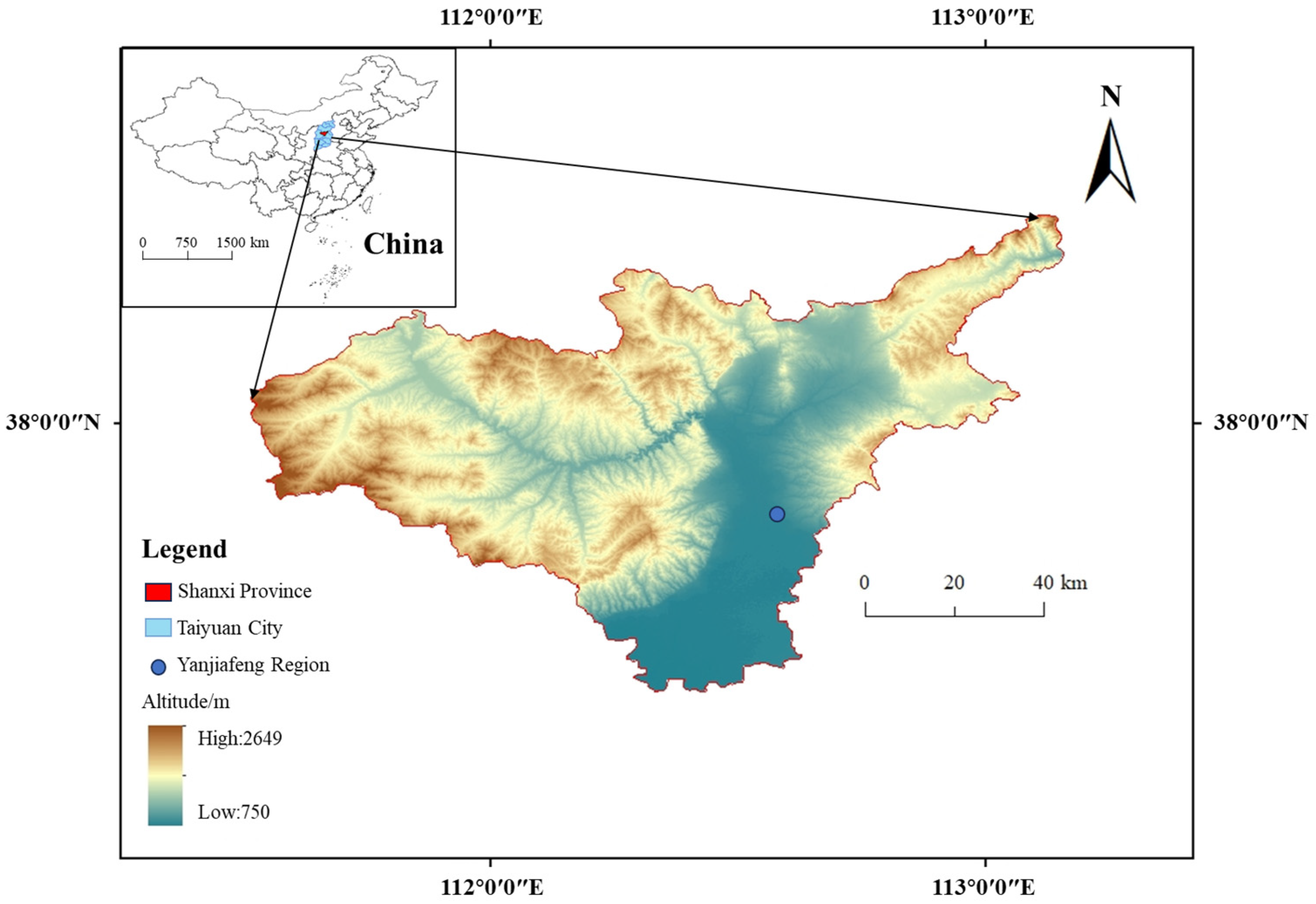
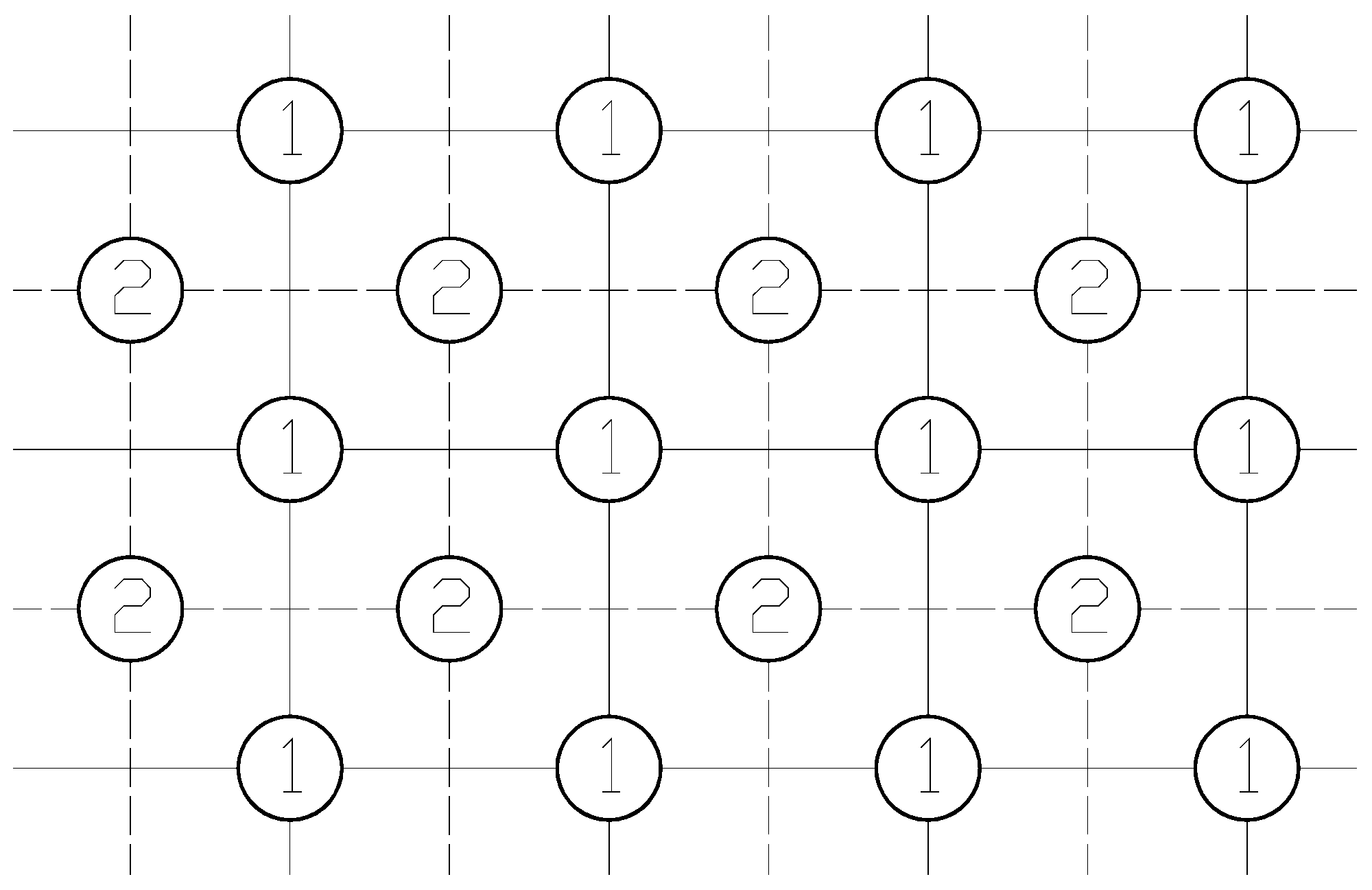

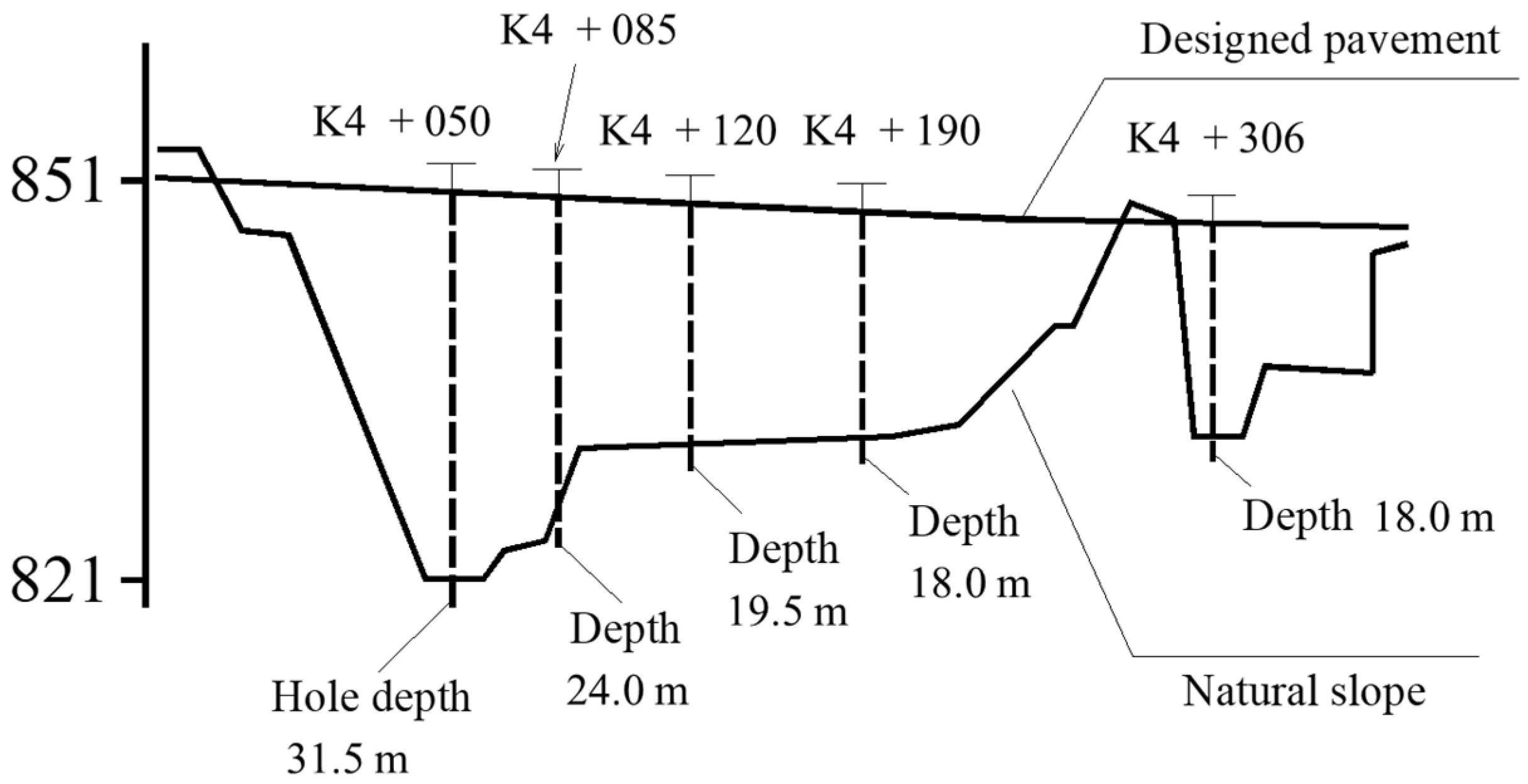


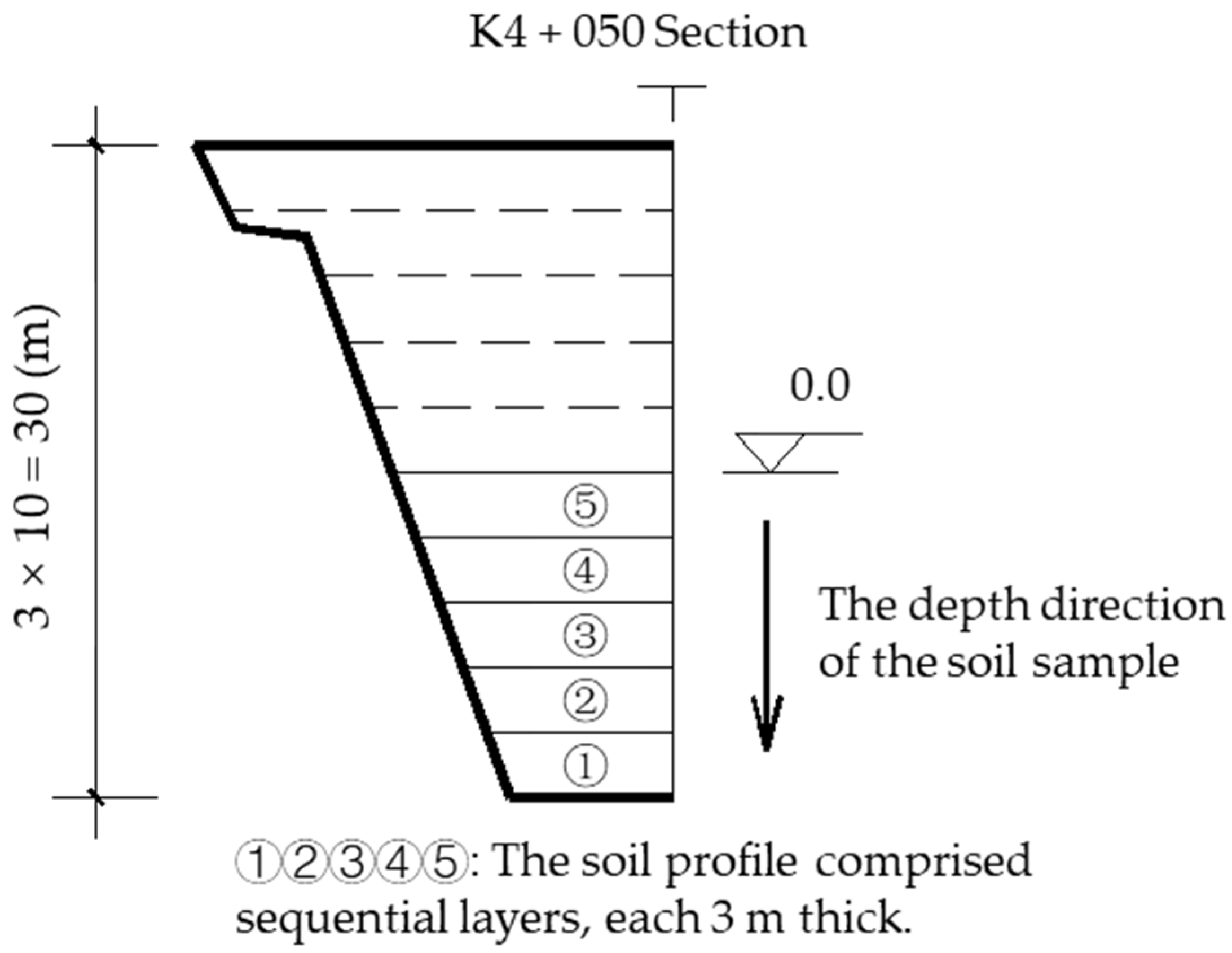
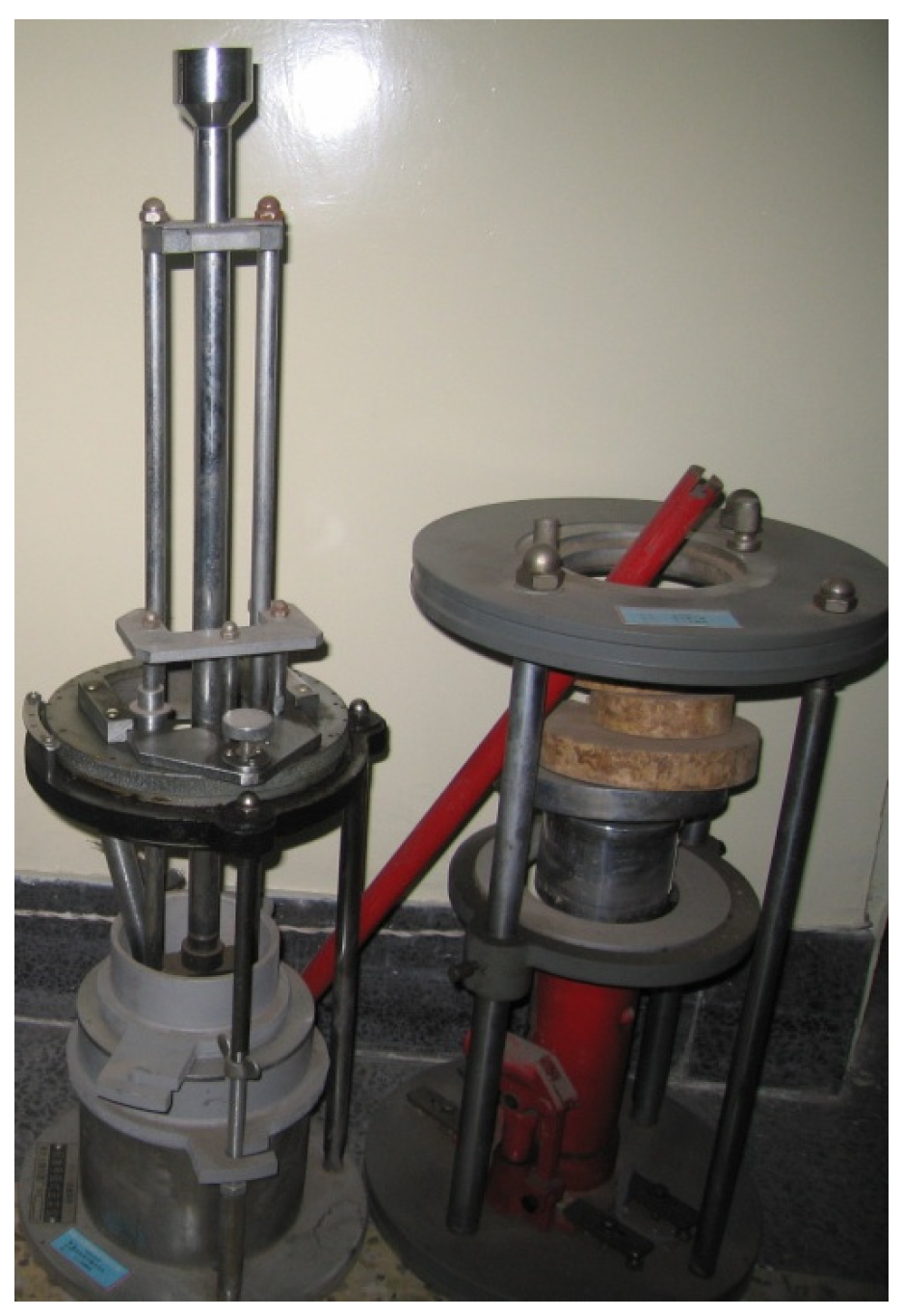








| Project Name | Height of Fill (m) | Filling Type | Post-Construction Settlement of the Filling Body (mm) | Settlement Value/Height of Fill |
|---|---|---|---|---|
| A loess-filled high embankment in the Jining–Fengzhen section of freeway 208 | 11.45 | Loess | 64.53 | 0.56% |
| A loess-filled high embankment in Shanxi Province | 24.8 | Loess | 135.9 | 0.5% |
| A loess-filled high embankment in Gansu Province | 24 | Loess | 390 | 1.6% |
| Physical Index | Percentage of Moisture (%) | Natural Density (kg/m3) | Liquid Limit WL (%) | Plastic Limit WP (%) |
|---|---|---|---|---|
| Average value | 17.14 | 1.62 × 103 | 24.09 | 14.55 |
| Filling Thickness (m) | h2/h1 | (h1 − h2)/h1 |
|---|---|---|
| 9 | 0.618 | 0.382 |
| 12 | 0.617 | 0.383 |
| 15 | 0.617 | 0.383 |
| 18 | 0.615 | 0.385 |
| 21 | 0.614 | 0.386 |
| 24 | 0.613 | 0.387 |
| 27 | 0.613 | 0.387 |
| 30 | 0.612 | 0.388 |
| Section | Total Settlement (mm) | Ground Settlement (mm) | Fill Settlement (mm) |
|---|---|---|---|
| K4 + 050 | 30.61 | 3.02 | 27.59 |
| K4 + 190 | 16.08 | 1.40 | 14.68 |
| Model | Mathematical Expression | Fitting Parameters | R2 |
|---|---|---|---|
| Linear function | y = kx + b | k = 0.0826, b = 4.5266 | 0.66 |
| Exponential function | y = y0 + keax | y0 = 32.4670, k = −33.2340, a = −0.0068 | 0.86 |
| Logarithmic function | y=aln(x) − b | a = 10.0639, b = 29.7595 | 0.92 |
| Power function | y = kxa | k = 1.0089, a = 0.5854 | 0.81 |
Disclaimer/Publisher’s Note: The statements, opinions and data contained in all publications are solely those of the individual author(s) and contributor(s) and not of MDPI and/or the editor(s). MDPI and/or the editor(s) disclaim responsibility for any injury to people or property resulting from any ideas, methods, instructions or products referred to in the content. |
© 2025 by the authors. Licensee MDPI, Basel, Switzerland. This article is an open access article distributed under the terms and conditions of the Creative Commons Attribution (CC BY) license (https://creativecommons.org/licenses/by/4.0/).
Share and Cite
Cheng, Y.; Zhao, C.; Zeng, G.; Ju, Y. Compression Characteristics of Highly Compacted and Tamped Loess Soil Fills. Buildings 2025, 15, 1291. https://doi.org/10.3390/buildings15081291
Cheng Y, Zhao C, Zeng G, Ju Y. Compression Characteristics of Highly Compacted and Tamped Loess Soil Fills. Buildings. 2025; 15(8):1291. https://doi.org/10.3390/buildings15081291
Chicago/Turabian StyleCheng, Yimei, Cheng Zhao, Guohong Zeng, and Yuwen Ju. 2025. "Compression Characteristics of Highly Compacted and Tamped Loess Soil Fills" Buildings 15, no. 8: 1291. https://doi.org/10.3390/buildings15081291
APA StyleCheng, Y., Zhao, C., Zeng, G., & Ju, Y. (2025). Compression Characteristics of Highly Compacted and Tamped Loess Soil Fills. Buildings, 15(8), 1291. https://doi.org/10.3390/buildings15081291






